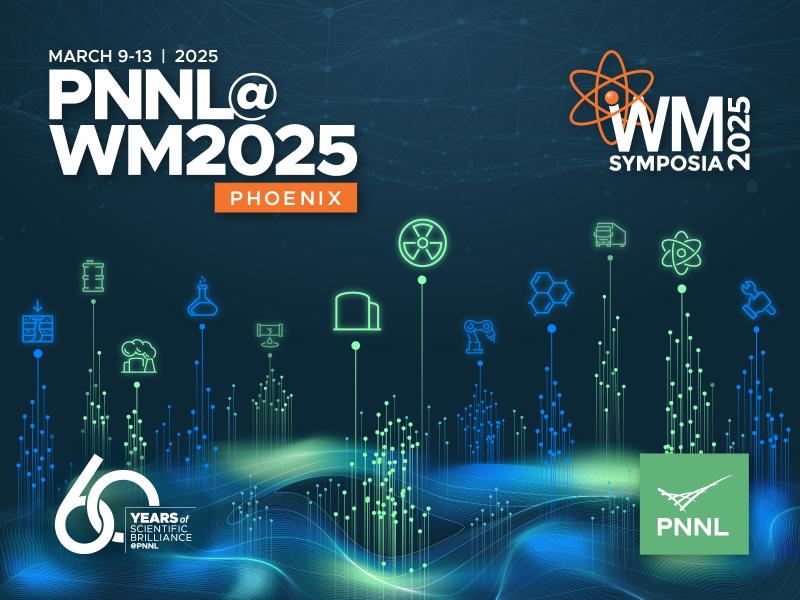Fuel Cycle
Research
Fuel Cycle
Research
Innovative nuclear fuel
concepts and methods
Innovative nuclear fuel
concepts and methods
Starting in Spain, a test cask containing simulated spent nuclear fuel (SNF) rods and assemblies gathered data over 9,548 miles of travel, including transport by truck, ship, and rail, and transfer by crane from each mode to the next until reaching Colorado. The white box behind the cask housed two data acquisition boxes, 20 batteries, and scores of cables connected to sensors that collected 512 to 10,000 data points every second. The data can be used to inform Nuclear Regulatory Commission regulations on the transport of SNF and to help industry better understand the performance of storage and transportation casks.
Honored with a DOE Secretary of Energy's Achievement Award in 2018, the international team include PNNL, Sandia National Laboratories, Equipos Nucleares, S.A. (ENSA) and ENRESA (Empresa Nacional de Residuos Radiactivos, S.A.) of Spain, Transportation Technology Center, Inc., Korea Radioactive Waste Agency, Korea Atomic Energy Research Institute, and KEPCO Nuclear Fuel.
PNNL draws on a decade of innovation and experience in the nuclear fuel cycle. Scientists and engineers develop and evaluate new, safer, and economically improved fuels; improve methods for fuel fabrication; and evaluate alternative means of recycling, storing, and transporting spent nuclear fuel.
Much of this work is sponsored by the Department of Energy (DOE) Office of Nuclear Energy (NE) and the Nuclear Regulatory Commission (NRC), in partnership with the nuclear industry and other national laboratories.
Advanced nuclear fuel
PNNL capabilities include online process monitoring, radiochemistry, and irradiated materials examination to better understand fuel performance and to speed the development and qualification of improved fuels.
For example, PNNL is among the DOE national laboratories working with industry to model, simulate, and evaluate accident-tolerant fuels (ATF). On behalf of the NRC, PNNL also reviews advanced fuel concepts submitted by industry vendors.
It is important to understand how advanced alloys and materials will perform under the harsh operating environments of advanced reactors. PNNL draws upon hot cell facilities and advanced microscopy techniques to integrate atomic-resolution chemical imaging, materials processing, surface modification, mechanical testing, and multiscale modeling to characterize and measure the performance of advanced materials.
Uranium is a key ingredient in nuclear fuel, but land-based mining comes with environmental issues. In 2018, for the first time, researchers at PNNL and LCW Supercritical Technologies in Moscow. Idaho, devised a unique way to extract naturally occurring uranium from seawater to make yellowcake, a powdered form of uranium. This approach could eventually provide commercially attractive nuclear fuel from the oceans, the largest source of uranium on earth.
Fuel fabrication
PNNL develops and tests new fabrication and extrusion methods to make fuel for advanced reactors. For instance, researchers developed oxide dispersion cladding using advanced extrusion techniques for uranium-molybdenum and uranium-zirconium alloys. PNNL’s hot cells, mechanical test frames, and microscopy assets provide testing and nano-level evaluation of new fuels, cladding, and associated materials.
Spent fuel disposition
Spent nuclear fuel (SNF) still retains significant residual energy and must either be recycled to recover fissile material for additional use or stored securely for eventual disposal. PNNL has a history of innovation in immobilizing, transporting, storing, or reprocessing SNF. For example, nuclear experts are establishing technologies and testing processes to support proliferation-resistant management of spent fuel. To this end, scientists have developed safer aqueous solvent-extraction processes, off-gas capture and treatment technologies, and high-level waste vitrification methods, as well as spent fuel recycling technologies that produce materials with no proliferation potential.
Researchers at PNNL have developed non-destructive examination (NDE) methods for assuring the integrity of vessels for storing and transporting fuel. PNNL also has conducted extensive testing and analysis of the performance of spent fuel casks under conditions of multi-modal transportation. PNNL was part of an international team that won a 2018 DOE Secretary of Energy Achievement Award for a demonstration in which an instrumented cask of simulated SNF was transported across 9,400 miles of ocean and land to measure forces on the spent fuel that would occur during normal transportation conditions. Industry and government are using the data to understand the performance and regulation of storage and transportation casks.
As advanced nuclear fuels evolve, PNNL will continue to play an important role in their development, deployment, and disposition.


